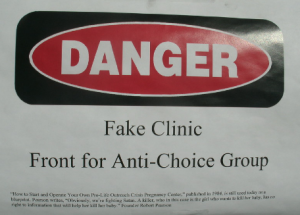
by Arielle Silver-Willner
The Fake Abortion Clinics That Mislead Patients

You’re well aware of the dire state of reproductive justice in the United States. You know that recent legislative moves such as the so-called “Heartbeat Bills” and the reduction of funding for Planned Parenthood severely threaten the lives of all folks capable of pregnancy or experiencing health conditions that affect the female reproductive system.
But there’s another threat to reproductive justice which works in tandem with these laws. Because even as abortion access gets choked by a million restrictions, Crisis Pregnancy Centers proliferate.
CPCs, also known as “fake abortion clinics” or, euphemistically, “Pregnancy Resource Centers” are essentially anti-choice hubs of misinformation. Often located in close proximity to an abortion-providing women’s health center such as Planned Parenthood, they aim to reach pregnant, option-seeking people before they make the choice to terminate. Many are religiously affiliated. However, as nonprofit organizations, they are also eligible to receive Title X funding.
In New York City, CPCs must adhere to legal guidelines intended to ensure that visitors are aware that they are not entering an abortion clinic, or even a medical center. New York City Local Law 17 requires these offices to display disclosure statements in both English and Spanish, advising visitors that they do not employ licensed medical professionals, and thus conveying that they will be receiving social services, but not medical services. However, Centers outside of NYC are entirely unregulated, as they are not technically medical centers or businesses. Even so, they can and do interfere with the health of their “patients.”
During a consultation with a CPC employee, a service-seeker can expect to be provided with preliminary testing to confirm pregnancy, but this is where the science ends. Visitors are often subjected to countless layers of manipulations, as counselors may misrepresent the risks of abortion, which is generally a safe procedure, disclose inaccurate gestational age, and invalidate their “patients’” concerns. They are known to deny requests for information regarding where to find an abortion provider. Guests seeking contraception may be given deceptive information about the side effects and long term risks of birth control. And regardless of age, cause of pregnancy, or physical or mental health, the ultimate goal is to convince people who are often not in the position to carry a pregnancy to full term, to do so.
CPCs in NYC that do not have adequate signage risk losing their 501(c)(3) status. And yet, it is suspected that many still receiving funding are in violation of this seemingly elementary law, or have discovered loopholes, such as displaying contradicting and/or inconspicuous information. And because so many set up shop mere steps away from true women’s health clinics, it is quite easy to mistakenly stumble into a misleading and potentially dangerous situation. There are also reports of CPCs in some states that have been discovered abusing their Title X funding to widen their networks of anti-choice influence. Thus we may conclude that public money is being used to deceive and endanger people in crisis.
There are believed to be more than 120 Crisis Pregnancy Centers in New York State alone. This number may seem small, but Guttmacher Institute notes that, as of 2017, while there were 252 facilities providing abortion in New York, just 113 were clinics that offer low cost or free services. This means that there are more centers providing free “abortion alternatives” than there are those providing free or low cost abortions and other reproductive health services in the state. Thus, for low-income people, it would theoretically be easier to access support from a CPC than from a medical facility.
But these are not insurmountable numbers. It should be possible to better regulate all Crisis Pregnancy Centers– and perhaps, in New York, we soon will.
According to Donna Newton, co-chair of WHARR (the Women’s Health and Reproductive Rights working group of the Brooklyn-based activist campaign GetOrganizedBK), there is a state bill, #A.8212/S.6311, currently in the works that “would call for a state-wide study of CPCs and an associated report with findings, conclusions, and recommendations to the Governor and Legislature.” Some of WHARR’s recent and ongoing activity is focused on gathering information and educating their community about CPCs, and they believe that this study is the potential first step in the process of tightening the reins on these harmful institutions. The bill was introduced to the state Legislature and will likely reach the floor of the Assembly and Senate. However, there are concerns that it may not receive sufficient support from NYS elected officials in purple districts who received constituent opposition for supporting the sweeping Reproductive Health Act during its passage, and thus may be resistant to further legislation of this nature.
So, what can we do to get this bill passed? Newton suggests that we reach out to New York State elected officials to express constituent concern about these institutions that are misleading vulnerable people. She affirms, “Our taxpayer dollars are being used to fund lying to people.” Through January 2020 you can call or write your Assembly Member and State Senator to ask them to support Bill #A.8212/S.S6311 in the upcoming legislative session. Newton and her co-WHARRiors consider this a “proactive and meaningful step to take.” They also recommend viewing the documentary LifeHouse for a neutral presentation of the reality of CPCs.
To learn more about Crisis Pregnancy Centers, WHARR, or bill #A.8212/S.S6311 visit https://www.wharr.com.
To find other ways to take action or for unbiased pregnancy services for visit https://www.protruthny.org/.
Arielle Silver-Willner is an intern at Lilith. She graduated from Connecticut College in 2018 and lives in Brooklyn, NY. When not in the Lilith office, she nannies and writes fiction.
The views and opinions expressed in this article are the author’s own and do not necessarily reflect those of Lilith Magazine.
